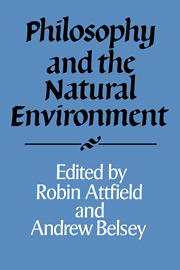Book contents
- Frontmatter
- Contents
- Preface
- Notes on Contributors
- Introduction
- Value in Nature and the Nature of Value
- Ecology and the Ethics of Environmental Restoration
- Rehabilitating Nature and Making Nature Habitable
- Personalistic Organicism: Paradox or Paradigm?
- Values, Reasons and the Environment
- Awe and Humility: Intrinsic Value in Nature. Beyond an Earthbound Environmental Ethics
- The End of Anthropocentrism?
- Global Religion
- Kant and the Moral Considerability of Non-Rational Beings
- The Idea of the Environment
- Chaos and Order, Environment and Anarchy
- Natural Capital
- Some Philosophical Assessments of Environmental Disobedience
- Global Environmental Justice
- Environmental and Medical Bioethics in Late Modernity: Anthony Giddens, Genetic Engineering and the Post-Modern State
- Highlights and Connections
- Bibliography
- Index
Values, Reasons and the Environment
Published online by Cambridge University Press: 19 October 2009
- Frontmatter
- Contents
- Preface
- Notes on Contributors
- Introduction
- Value in Nature and the Nature of Value
- Ecology and the Ethics of Environmental Restoration
- Rehabilitating Nature and Making Nature Habitable
- Personalistic Organicism: Paradox or Paradigm?
- Values, Reasons and the Environment
- Awe and Humility: Intrinsic Value in Nature. Beyond an Earthbound Environmental Ethics
- The End of Anthropocentrism?
- Global Religion
- Kant and the Moral Considerability of Non-Rational Beings
- The Idea of the Environment
- Chaos and Order, Environment and Anarchy
- Natural Capital
- Some Philosophical Assessments of Environmental Disobedience
- Global Environmental Justice
- Environmental and Medical Bioethics in Late Modernity: Anthony Giddens, Genetic Engineering and the Post-Modern State
- Highlights and Connections
- Bibliography
- Index
Summary
By 2030, according to one reliable source, the world's population will have increased by 3.7 billion, demand for food will have nearly doubled, and industrial output tripled (World Bank, 1992, p. 2 and passim). Consider two possible histories of the world in this period:
The Admirable (A) History. Wastage of energy and natural resources is reduced, as is poverty in developing countries. Pollution decreases. Greenhouse warming slows. Biodiversity is preserved. The natural environment is protected. Food is not short.
The Bleak (B) History. Widespread wasteful consumption practices continue. Air pollution increases. Greenhouse warming continues. Biodiversity decreases. Water contamination, deforestation and desertification are widespread. Sea levels rise. Food shortages cause local wars.
It is obvious that, other things being equal, the history of the world will be better the closer it comes to the A-History. But it is less obvious why it is better, or quite what its good aspects might be. One might ask, for example, whether the ‘deep ecological’ view is correct that the condition of the environment in itself contributes to the superiority of the A-History (see Naess, 1973; Rolston, 1986a, esp. part II; Taylor, 1986; Rolston, 1988, esp. ch. 6; Callicott, 1993).
These are the first questions I shall consider (in §§ II—VIII).
- Type
- Chapter
- Information
- Philosophy and the Natural Environment , pp. 75 - 88Publisher: Cambridge University PressPrint publication year: 1994



